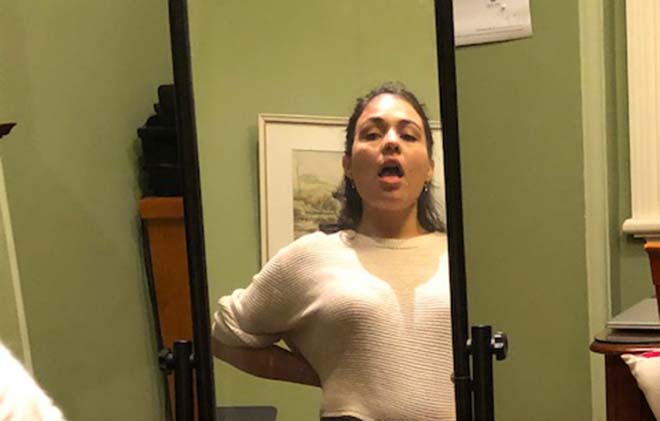A Strong Head Voice Makes You A More Versatile Singer
Do you struggle to hit high notes? Do you avoid songs with passages that call for using your head voice?
Singing in head voice is a common challenge for vocalists, but learning to find and develop your upper register will open you up to singing a wider range of material – which is definitely worth the effort!
WHAT IS HEAD VOICE?
When you sing in any pitch, specific muscles in your vocal tract and larynx adjust, to produce your chosen pitch sound. Singing in a higher register, your two vocal folds become thinner, more stretched and vibrate faster than for lower registers. These folds even tilt slightly, as ligaments and joints in the larynx adjust, so it can produce the higher-pitched sounds. Singers often feel the vibration in their head or face, hence the term ‘head voice’.
Your speaking voice is most likely in a low or middle register, so learning to sing in your head voice smoothly, and how to blend your middle voice to your head voice is an important skill to work on as a singer. Learning to master your head voice takes commitment, time and practice. Importantly, you need guidance from a professional singing teacher to help you take your head voice quality from thin and light to a more full-bodied, colourful voice.
HOW CAN YOU FIND YOUR HEAD VOICE?
At first, you may find it hard to shift into head voice, but with practice, you’ll notice where the difference is between your chest and head voice (AKA your ‘break’) so you can smooth and blend it. An exercise like a siren or ‘yawning sigh’ can help you pinpoint where your head voice meets your chest voice.
Learning how to keep your throat open creates a consistent flow of air, which you especially need for head voice singing. You also need to lighten the feel of your singing, and not take a weighted, heavy vocal quality into your upper register.
For most women, the upper register starts at about E or F, an octave above middle C. You’ll notice that singing with too much weight up above these notes becomes strained and feels uncomfortable. Some women can sing as high as E flat – two octaves above middle C.
For men, the upper register depends on whether you are a bass or a tenor voice. Men with bass voices start their upper register between A below middle C to D4 (D above middle C) and baritones can go up to A above middle C. Tenors can begin their upper register at E above middle C and go up to C above or higher. With practice, men can move into their real head voice.
It is important to note that head voice is not falsetto. Falsetto is the lightest male voice sound – the sound of a man’s boyhood voice, before it drops in puberty. Women do not have a falsetto voice, as some believe. And while men can often take their falsetto voice well below middle C, working in falsetto generally helps men access and strengthen their head voice (LINK).
HOW TO STRENGTHEN YOUR HEAD VOICE
As with any singing skill, the only way to improve is through regular practice and singing exercises.
One exercise to help you feel the upper vibrations in your voice is on the sound ‘wee’. Start with a simple five notes coming down from about C4 for men or E5 (an octave above middle C) for women. Take these at a moderate to fast speed.
- Open your throat and the back of your mouth on an in breath.
- Put ‘W’ on the first note, lightly and clearly, and continue on ‘ee’ as you descend five notes.
- Continue going up in semitone steps, in major keys.
- You will find at F5 for ladies and D4 for men that you need to ‘turn’ or adjust the feel of where your voice is. Let this happen. It won’t come straight away, but with practice you’ll find the feeling of squeeze or heaviness will begin to lighten as your brain and voice get used to going up higher.
STUDENT CASE STUDY: ERWIN DA SOUZA
Erwin has worked on his tenor voice. At first, he would flip into falsetto when high notes approached. Now he has really settled his voice, with more accurate pitching and he’s working into his full male head voic

e so that it’s becoming clear, well supported and easy. Erwin notes the importance of physical and mental preparation for smoothing the transition from chest to head voice.
“Training body and mind is essential. The body encompasses the physical voice and the mind encompasses how one must approach the repertoire,” he says. “With Kathleen, I’ve learnt to shape the physical aspects of voice through vocal ‘register stretching’ exercises.”
Working on his head voice for a few months, Erwin has realised it takes time to shift register effortlessly. This depends on many factors like tessitura, timbre, vocal weight, range, along with the good breath and muscle support required for his preferred classical repertoire.
“Kathleen continues to challenge me with repertoire aimed at shaping these aspects of the voice, especially where intervals are an octave apart either high or low or at the register break, requiring smooth change between middle and head voice,” he says. “The head voice is absolutely essential for me because it is where I sound the most effective and where I’m most comfortable singing. I honestly struggled before training with Kathleen, but I’ve come a long way and it has allowed me to sing some advanced repertoire with a prominent chorus.”
Your head voice register is exciting, challenging and vital to singing a wider range of songs. Once you learn how to use this upper register smoothly and with clarity, you’ll enjoy the breadth it adds your vocal abilities. And so, will your audience!
Let Kathleen Connell help you find and finesse your head voice. Get in touch.



